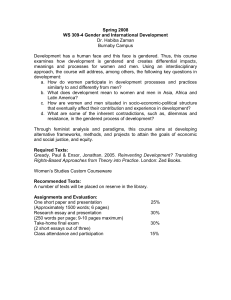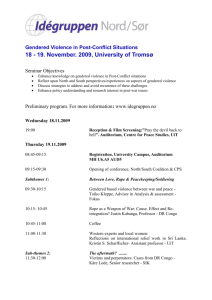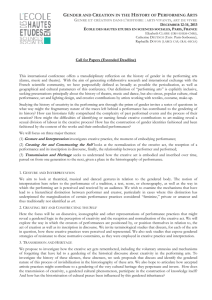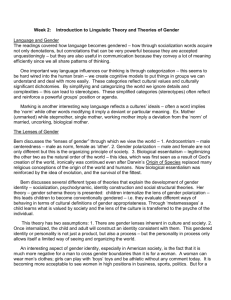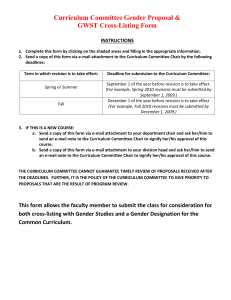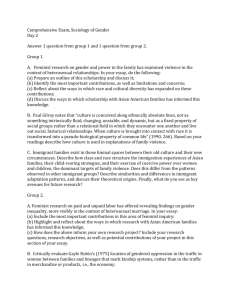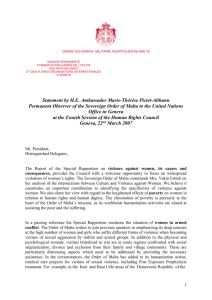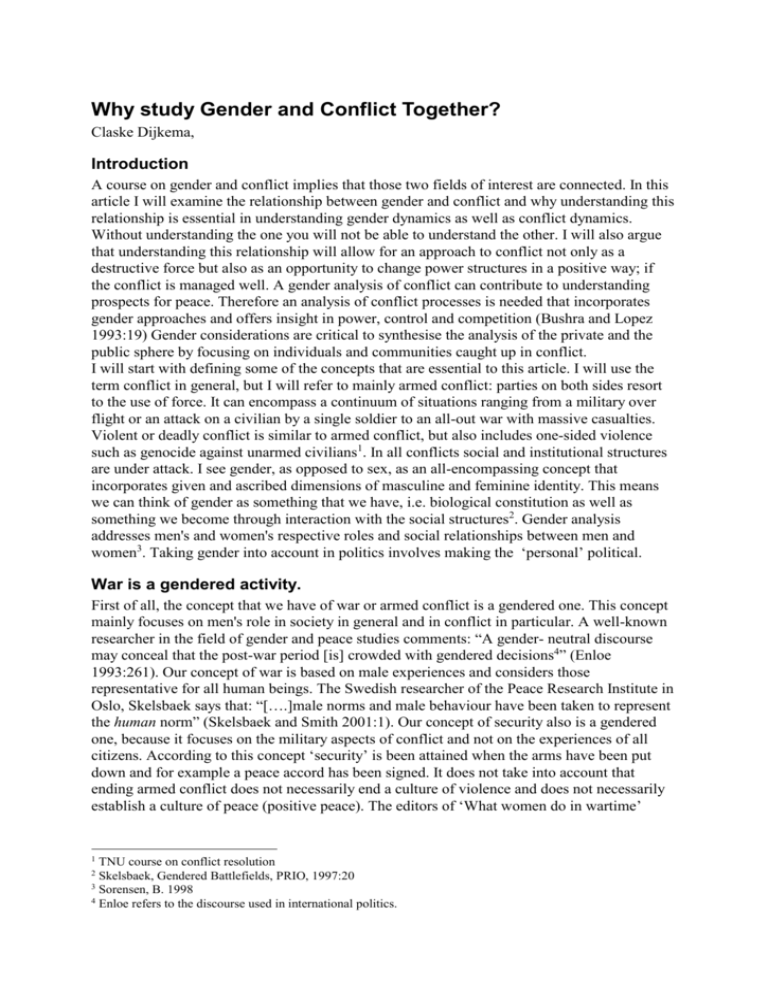
Why study Gender and Conflict Together?
Claske Dijkema,
Introduction
A course on gender and conflict implies that those two fields of interest are connected. In this
article I will examine the relationship between gender and conflict and why understanding this
relationship is essential in understanding gender dynamics as well as conflict dynamics.
Without understanding the one you will not be able to understand the other. I will also argue
that understanding this relationship will allow for an approach to conflict not only as a
destructive force but also as an opportunity to change power structures in a positive way; if
the conflict is managed well. A gender analysis of conflict can contribute to understanding
prospects for peace. Therefore an analysis of conflict processes is needed that incorporates
gender approaches and offers insight in power, control and competition (Bushra and Lopez
1993:19) Gender considerations are critical to synthesise the analysis of the private and the
public sphere by focusing on individuals and communities caught up in conflict.
I will start with defining some of the concepts that are essential to this article. I will use the
term conflict in general, but I will refer to mainly armed conflict: parties on both sides resort
to the use of force. It can encompass a continuum of situations ranging from a military over
flight or an attack on a civilian by a single soldier to an all-out war with massive casualties.
Violent or deadly conflict is similar to armed conflict, but also includes one-sided violence
such as genocide against unarmed civilians1. In all conflicts social and institutional structures
are under attack. I see gender, as opposed to sex, as an all-encompassing concept that
incorporates given and ascribed dimensions of masculine and feminine identity. This means
we can think of gender as something that we have, i.e. biological constitution as well as
something we become through interaction with the social structures2. Gender analysis
addresses men's and women's respective roles and social relationships between men and
women3. Taking gender into account in politics involves making the ‘personal’ political.
War is a gendered activity.
First of all, the concept that we have of war or armed conflict is a gendered one. This concept
mainly focuses on men's role in society in general and in conflict in particular. A well-known
researcher in the field of gender and peace studies comments: “A gender- neutral discourse
may conceal that the post-war period [is] crowded with gendered decisions4” (Enloe
1993:261). Our concept of war is based on male experiences and considers those
representative for all human beings. The Swedish researcher of the Peace Research Institute in
Oslo, Skelsbaek says that: “[….]male norms and male behaviour have been taken to represent
the human norm” (Skelsbaek and Smith 2001:1). Our concept of security also is a gendered
one, because it focuses on the military aspects of conflict and not on the experiences of all
citizens. According to this concept ‘security’ is been attained when the arms have been put
down and for example a peace accord has been signed. It does not take into account that
ending armed conflict does not necessarily end a culture of violence and does not necessarily
establish a culture of peace (positive peace). The editors of ‘What women do in wartime’
1
TNU course on conflict resolution
Skelsbaek, Gendered Battlefields, PRIO, 1997:20
3
Sorensen, B. 1998
4
Enloe refers to the discourse used in international politics.
2
argue that violence against women still continues and even increases after men return form the
battlefield (Turshen and Twagiramariya 1998).
Not only is the concept of armed conflict gendered, also the practice of warfare is gendered.
Conflict takes place in a culture that assigns different roles to men and women and it therefore
impacts their lives differently. Men are often called to take part in the battle and to fight in an
army while women carry the responsibility for the household and the family. Women’s roles
traditionally have been more in the private sphere -and in many countries still are-, women
take care of the sick and wounded. Because structures in a society are gendered, these
structures can be reinforced during wartime. In Rwanda for example, where women are
accustomed to respect the man and to service him, they have become forced to do so. A
Rwandan researcher Twagiramariya reports on intsinzi, a practice in Rwandan culture
whereby many young girls and women offer themselves to the military to congratulate them
with their victory. During the civil war in 1994, they were even forced to service the soldiers
sexually; otherwise they would be accused of collaboration with the deposed regime and
threatened to be killed. (Turshen&Twagiramariya 1998:109). Researchers for Oxfam say that
armed conflict leads to the breakdown of political structures and economic systems, which
heightens women’s vulnerability and therefore has gender implications. (Bushra and Lopez
1994:) Vulnerability can be understood in a very literal way, in that the men who have either
fled or gone to war or that have been killed for example can no longer protect and provide for
the women. It can also be understood in a more symbolic way, that the cultural codes that are
custom in a society can no longer protect women, as is for example the case in a ‘dirty war’.
In order to understand armed conflict we have to understand that structures in our societies are
gendered, influence our concept of war and result in different experiences for men and women
during war due to their different roles in society. I will now go more into the experiences of
women during conflict. I will argue that their experiences have not received a lot of attention
because our societies are structured in such a way that women’s suffering remains invisible.
The invisibility of women’s suffering
In societies, where power differences between men and women are large, men often operate in
the political arena while women operate in what is considered the private arena of the home
and the family. Men inhabit the public domain while women are limited to the private domain.
In Afghanistan under the rule of the Taliban for example, women cannot participate in public
life unless completely veiled and accompanied by her husband or a male member of the
family. Only within her home can she claim some space of her own.
An implication of the distinction between public and private life is that people generally feel a
shared responsibility for what is public while what is private is beyond the control of the
public and therefore considered to be the responsibility of the family. Since home and family
are ‘personal’, most people have the feeling that they are not allowed to interfere. For exactly
this reason it has been very difficult to address domestic violence. Police approached domestic
violence as a family matter and therefore beyond the domain of common law. I’m arguing that
because of this gendered distinction in society between private and public, also in periods of
conflict, women’s suffering is invisible since it does not take place in the public domain.
Turshen and Twagiramariya support this view based on their experience with Rwandan
women. “Women tend to define their suffering in relation to other people such as their
husbands and children and are reluctant to make public their own experiences of abuse which
society often sees as belonging in the private realm (Meintjes and Goldblatt 1998:54). In
South Africa, women’s organisations have worked hard to make gender suffering under
apartheid publicly visible by means of the Truth and Reconciliation Commission. The
definition of ‘victim’ in the Truth and Reconciliation Act of 1995 includes relatives and
dependents of victims. This is important because it locates wives, mothers and children in
centre stage as having suffered ‘gross violations of human rights’ (Meintjes and Goldblatt
1998:34). The effort of women’s organisation can be seen as successful because it has made
the suffering of women visible in a political process.
The invisibility of women’s suffering concerning sexual abuse can be ascribed to the
existence of cultural taboos. As long as sexuality is not discussed in a society, it is hard for
women to speak out about sexual abuse. Instead they keep sexual assault and rape hidden out
of shame and guilt, feelings that imply personal responsibility as opposed to political acts.
Over the last fifty years there has been a movement within international law that has
politicised sexual assault and rape to release the burden that women feel personally. I will
further explore the history of connecting gender to international politics.
Over the last fifty years there is an increasing interest in gender and
conflict in the international politics discourse.
It was not until the sexual atrocities were committed during the conflict in former Yugoslavia
that references began to appear throughout the UN about the problem of sexual violence
during armed conflict. The Security Council referred in December 1992 for the first time to
the “massive, organised and systematic detention and rape of women, in particular Muslim
women in Bosnia and Herzegovina”. Between Nuremberg and Tokyo on the one hand and the
former Yugoslavia on the other, a strong and mobilized feminist movement has emerged that
is exerting pressure and demanding redress for atrocities specifically directed at women and
girls (Sorensen 1998). The United Nations has mainstreamed the gender dimension over the
last fifty years and a concept of peace as the absence of war has shifted to peace as a more
holistic concept.
In 1947 the United Nations Commission on the Status of Women was established. Its mandate
was to make recommendations and reports for the UN Economic and Social Council on
promoting Women’s rights in political, social, economic, civil and educational fields. The
theme of the commission was not new, but establishing a commission was. It can be seen as
an important first step in a series of efforts aimed at creating greater awareness about gender
issues and women’s issues in particular. The Four World Conferences on Women that
followed have demonstrated an increasing awareness about the impact of gender differences
on peace and conflict. The First World Conference on Women took place in Mexico City and
was the beginning of the UN Decade for Women. The success of this conference has been
limited because many controversies regarding women’s roles had not been resolved. Men
were still holding the important positions at the conference. During the United Nations
Decade for Women from 1975 until 1985 women of colour, poor women and lesbians
demanded space and recognition within the international feminist movement. These groups
called into question hegemonic understandings of feminism based on assumptions about the
universality of women’s experiences that took the daily lives, concerns, and priorities of
heterosexual white upper-middle class women in Europe and North-America as a model,
according to the Israeli feminist and peace activist Sharoni (Sharoni1995:13). In 1979, the
Convention on the Elimination of all Forms of Discrimination against Women (CEDAW)
made progress on gender equality in the sense that an agreement was signed that women and
men should be protected equally. It failed however to address abuses for which a male parallel
typically does not exist, like gendered violence and gender-related harms such as military
sexual slavery and forced prostitution (Etienne, M. 1995:147). In 1980, the Second World
Conference on Women took place in Copenhagen. The goal of this conference was to look
back at the previous five years to see what goals had been met and what new goals should be
set for the following five years. One outcome was that an interdisciplinary and multi-sectoral
World Survey on the role of women in overall development was initiated. The World Survey
showed the important role women played in economics and that they had not benefited from
‘development’. The first World Survey served as a major document in preparations for the
Third World Conference, held in Nairobi in 1985. This conference marked the end of the
United Nations Decade for Women and was the first where issues of peace and conflict
featured on the agenda. It outlined what are known as the Forward Looking Strategies that
made the themes of peace, equality and development the three main areas of concern.
Feminist reflections, concerns, and vocabulary concerning peace were made explicit in a
major UN document for the first time. Not only is the notion of women shifting over the
course of the World Conferences to gender but also the notion of war and conflict. In 1985
peace is defined not only as the absence of war, violence and hostilities at the national and at
the international levels but also the enjoyment of economic and social justice, equality and the
entire range of human rights and fundamental freedoms within society (par.13). One of the
implications of the document is that violence against women in the domestic sphere is defined
as a phenomenon of global concern. This was made further explicit in the Declaration on the
Elimination of violence against women in 1994. As opposed to the Convention on the
elimination of all forms of discrimination of 1979, the declaration of 1994 does include
recommendations specifically formulated for women in armed conflict. Unfortunately the UN
has no mechanisms yet to enforce such declarations. In 1995 the Fourth World Conference on
Women took place in BeijingAn increasing number of participants was present. Central
themes were the concept of gender and the connection between gender, peace and conflict,
which was even more central here than in Nairobi. The following UN Expert meetings
followed out of this conference. The UN Expert meeting in Santo Domingo looked at the
impact of gender differences in political decision-making and conflict resolution. It served as
a preparation for the meetings of the Commissions on the Status of women and as a follow-up
on the Conference in Beijing.
The 41st Session of the Commission on the Status of Women in 1997 focused specifically on
women in power-and decision-making as result of the conference in Beijing. In1998 the 42nd
Session of the Commission on the Status of women focused on women in armed conflict.
The 23rd Special Session of the UN General Assembly produced a document proposing further
actions and initiatives to implement the Beijing Declaration and Platform for Action, titled:
Women 2000: Gender Equality, Development and Peace for the Twenty-First Century.
In short we can say that the considerable progress has been made over the last years in
introducing the gender dimension in the discourse of international politics.
Conflict can be seen as an opportunity to change gender roles
“Paradoxically, the conflict [civil war in Chad] has also had a ‘positive impact of Chad’s
women, empowering them in unexpected ways.” (Turshen and Twagiramariya 1998:118)
hopefully, mainstreaming gender in the discourse on conflict will make people sensitive for
the opportunities that conflicts can present and to learn how to use those. In reading many
stories of women in wartime, I have been surprised by the unexpected changes in gender
relations as a result of war that women have reported. Roles -that formerly had been very
fixed in their society- were suddenly shifting as the result of war. I will give two examples,
one from Chad and one from Sudan. Oxfam Women’s Project Officer in Chad, Achta Djibrine
Sy, notes that during the civil war in Chad in 1979 many men went into exile or were unable
to provide for their families. Women partly took over this role to provide for their families,
which gave them a feeling of independence and changed their self-image from one of
dependence to independence. Before the outbreak of civil war the status of women in Chad
had been confined to biological and social reproduction. The social disorder brought about by
the war transformed gender relations. A conflict situation can thus enable women to leave the
private sphere and participate in the public domain. (Turshen and Twagiramariya 1998:118)
Another example comes from Sudan. Asma Abdle Halim, a Sudanese human rights lawyer,
observes that gender roles are shifting among displaced families in Sudan. She observes that
men are less prepared than women to take on manual labour in order to earn an income for
their families. Many displaced Sudanese men stay at home with the children while women are
going out to work Whether this will lead to a long-term change after the war is questionable
however because Sudanese men are not optimistic about a future with women who have real
power. Women fear violence if they insist on their newly acquired status (Turshen and
Twagiramariya 1998:90) How these changes in gender roles during the conflict impact gender
roles in the long run I have not yet explored. There are reports though that there are drawbacks
after the conflict and that women are not included in decision-making processes. Women still
lack at the negotiating tables and therefore have no official role in ending the armed conflict
nor in planning constructing a more peaceful society.
Conclusion.
Gender and conflict should be studies together because ignoring the gender dimension of
social reality makes it impossible to address crucial elements of Conflict resolution. It will
also lead to missing opportunities like failing to use the contributions that women can make in
resolving conflicts and reconstructing their countries after the war.
Bibliography
Abdel Halim, Asma (1998) ‘Attack with a friendly weapon’ in What women do in wartime.
London: Zed Books.
El Bushra, Judy and Piza Lopez, Eugenia (1994) Development and Conflict: the Gender
Dimension . Oxford: Oxfam.
Enloe, Cynthia (1993) The morning after, sexual politics at the end of the Cold War Berkeley:
University of California Press.
Etienne, M. (1995) ‘Addressing Gender-based Violence in an International Context’ Harvard
Women’s Law Journal, Vol.18, pp.139-70 in What women do in wartime.
Goldblatt, Beth and Meintjes, Sheila (1998) ‘South African Women demand the Truth’ in
What women do in wartime. London: Zed Books .
Sharoni, Simona (1995) Gender and the Israeli-Palestinian Conflict. Syracuse: Syracuse
University Press.
Skelsbaek, Inger and Smith, Dan (2001) Gender, Peace and Conflict, PRIO. London: Sage
Publications.
Sorensen, Birgitte (1998) Women and Post-Conflict reconstruction. War-torn societies Project
Occasional Paper No.3. UNRISD.
Turshen, Meredith and Twagiramariya, Clotilde ed. (1998) ‘Women’s War stories’ in What
women do in wartime: Gender and Conflict in Africa. London: Zed Books.

